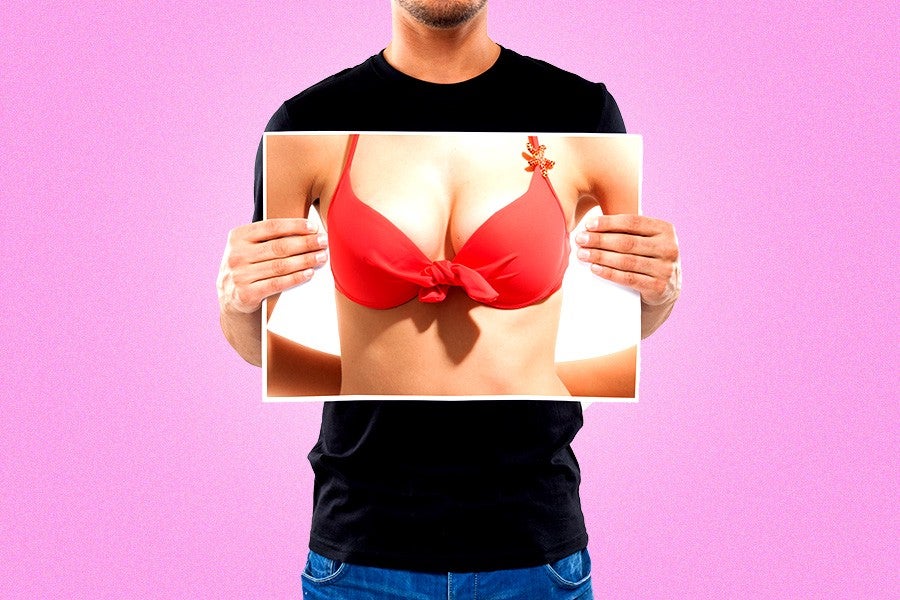Full disclosure: Writing about how lavender essential oil can make you grow man boobs has turned me into a hypochondriac. I’m afraid that everything I ingest will inevitably result in shapely melons sprouting from my chest. In an attempt to put my fear to rest, I’ve spent some time researching all the things that cause gynaecomastia (aka, man boobs). And if I have to live with this knowledge, so do you. Here’s what I learned…
Puberty
Puberty is by far the most prevalent cause of man boobs: One-half of adolescent boys will experience gynecomastia, with peak onset between the ages of 13 and 14. That’s because puberty leads to an increase in estrogen levels, and when the ratio between testosterone and estrogen tips in favor of estrogen, the body responds by creating excessive breast tissue. Fortunately, pubertal gynaecomastia usually works itself out within a few years: Only 10 percent of boys have persistent gynecomastia by age 17.
Even still, this brief experience with gynaecomastia can be especially debilitating for young men. “It can be embarrassing,” explains Frederic Corbin, a plastic surgeon who specializes in gynecomastia surgery. “Take the communal showers in high school: People poke fun at them, and call them bitch tits.” Even worse, gynaecomastia can persist beyond puberty if the hormones don’t resolve themselves.
Steroids (and Other Drugs)
After persistent pubertal gynecomastia, medications and substances that affect hormone levels are the most common causes of gynecomastia — common contributors include antipsychotics, antiretrovirals (HIV drugs) and prostate cancer therapies with long-term use. Steroids are also particularly troublesome: Studies found that a whopping 52 percent of patients who regularly use anabolic steroids experience gynecomastia. “Steroids are converted by the body (often fat cells) into estrogen,” leading gynecomastia surgeon Joseph Cruise writes in a recent report. “This increase in estrogen levels is what can cause men to develop unwanted breast tissue.” Corbin adds that protein powders and testosterone boosters “clearly” lead to gynecomastia, because they similarly cause hormone fluctuations.
Weed
While it hasn’t been proven, Corbin mentions that smoking pot may contribute to gynecomastia. Science generally corroborates his claim: Animal studies have shown that exposure to THC can cause a decrease in testosterone levels, which may lead to gynecomastia. But older studies disagree: A military survey from 1977 found no link between smoking cannabis and growing breasts — although, the survey was admittedly limited due to its tiny sample size. More research on the matter should emerge soon, since legalization has made it easier for researchers to examine the effects of cannabis on hormone levels.
Estrogen-Rich Foods
Certain foods — e.g., dried fruits, flax seeds, soy and tofu — are high in estrogen-like phytoestrogens, which might contribute to gynecomastia. That said, Corbin mentions that phytoestrogen-rich foods are more likely to affect people who are already prone to gynecomastia (like those who experienced it in puberty). A 2010 study of soybeans concludes with this optimistic statement: “The intervention data indicate that isoflavones [phytoestrogens in beans and legumes] do not exert feminizing effects on men at intake levels equal to and even considerably higher than are typical for Asian males.”
Various Diseases
Cirrhosis (chronic liver damage) may impair your ability to break down estrogen, which can lead to gynaecomastia. Those with alcohol-related liver diseases are particularly at risk, because ethanol (the alcohol commonly found in booze) inhibits testosterone production and can disrupt the estrogen-to-testosterone ratio.
Hypogonadism (a failure of the gonads and the hormones they produce) can also cause gynaecomastia; so can hyperthyroidism (the overproduction of hormones by the thyroid) — gynecomastia occurs in 10 to 40 percent of men with hyperthyroidism.
Tap Water
While it’s true that trace amounts of birth-control pill ingredients (which include estrogen) are present in many tap-water supplies — most of which is inadvertently released into sewers through the urine of women who are taking birth control — they account for less than one percent of the estrogen found in the drinking water (the rest comes from soy and dairy products, as well as animal waste that’s been used as farm fertilizer). So while it’s possible that the estrogen in our drinking water might contribute to gynaecomastia, the pill certainly isn’t to blame.
Welp — *washes down dried fruit with tap water, hits bong* — looks like I better go bra shopping.

